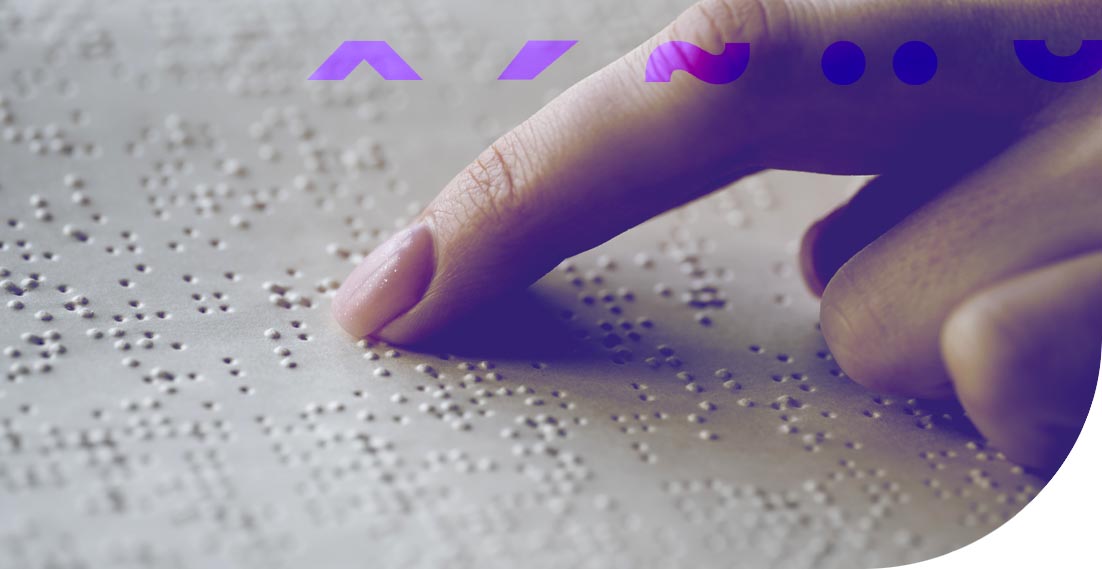Braille – everything you need to know about it

There are 285 million visually impaired people in the world. According to the World Health Organization, there are 0.2% blind and 1.3% visually impaired people in Europe. This number increases as the average life expectancy increases. Thus, visual impairment is a real problem that needs to be addressed and that includes Braille translations, in order to improve the quality of life of such people.
How can this be done? What does such a translation for visually impaired people involve?
Join us and work as a translator
Characteristics of Braille
Braille coding is one of the possibilities for visually impaired people to access information.
The Braille code consists of a sequence of 6 dots arranged in two columns. The combination and arrangement of the dots provide the possibility of creating 64 characters.
The international base of the alphabet consists of the first 25 characters and the character for the letter “w”, as well as punctuation and auxiliary characters, which, despite some differences between the varieties of the Braille system, are generally universal in particular languages.
English Braille alphabet
Braille – is it only one language?
The Braille code became the starting point when it came to the development of various writing systems using characters from the alphabet. This contributed to the fact that there is an integral script (letter by letter), orthographic abbreviation of various degrees, depending on the country and the specificity of a given language, as well as mathematical, musical, chemical and physical notations.
Integral writing, known as Braille Grade 1 or Uncontracted Braille, is the faithful writing of text letter by letter and character by character.
The abbreviation is obtained by substituting letters or words for individual Braille characters, and it is not phonetic.
History of Braille – how was a special language for the blind created?
Braille was invented in 1829 by Louis Braille. As a result of an accident, he lost his sight at the age of three. As a result, he attended the Royal Institute for the Young Blind, founded by Valentin Haüy. Reading and writing were taught there using a special embossed alphabet, but this method had many disadvantages.
In 1821, Louis Braille met Charles Barbier de la Serre, the inventor of a simple ultrasound system that could later be used by the blind. This system called “night writing” was intended to allow officers to write or read encrypted messages in the dark. The principle of sonography was the transcription of sounds (36) with the use of protruding dots placed on a grid of 2 × 6 dots.
It wasn’t until 1819 that Barbier realised the advantages a blind person could derive from his system. He designed a new system for the blind, which he presented in 1821 to the Royal Institution for Blind Youth.
After several years of research based on his method, Louis Braille developed the orthographic Braille known today.
The most important features of the system developed by Braille are:
– reducing the number of points used from 12 to 6;
– encoding Latin typographic characters (letters, punctuation, notes, etc.) instead of sounds.
The key part of the system was developed in 1825 (Braille was 16 at the time), he published his first treatise in 1829.
Earlier attempts to create an alphabet for the blind
Louis Braille, however, was not the precursor of a writing system for the blind.
In the 14th century, an Iraqi Muslim lawyer, Zayn Ud Dîn Al Âmidi, who was blind, also envisioned a system whereby the blind could have access to books. The way of reading was based on touch.
In the 17th century, an Italian Jesuit, Francesco Lana de Terzi developed various coded writing systems for blind people. In particular, he designed the Lana system, a protruding printing process on thick paper, as well as “a system that allows blind people to write smoothly by only drawing lines and making dots.”
Valentin Haüy, a writer and linguist, influenced by a spectacle with the participation of the blind at the Saint-Ovide fair, became fascinated by their education and wanted to teach them how to read. For this purpose, he commissioned special relief and movable figures, and in 1784 he successfully accepted the challenge of teaching a young blind man. This method was used in a facility for blind children, the first school of this type.
Learn Braille from scratch
Learning Braille is just like learning a foreign language – it takes time and patience. It is estimated that it takes two years to read and write the abbreviated version correctly. Braille is not only learnt by blind people. Transcription of texts is generally prepared by sighted volunteers. After eight months of study, you can even rewrite a novel.
Braille is created in different ways. You can use a metal or plastic board and a punch, which is a special typewriter whose six keys correspond to the six dots of a Braille cell – or a computer that translates, transcribes and reproduces Braille. In fact, it was computers that generated the new possibilities for capturing, reproducing and remotely transmitting texts in this alphabet.
Music in Braille
Visually impaired musicians learn to read Braille in the same way that sighted musicians learn to read printed musical notes. The difference is that it is only possible after learning how to read Braille text.
Music notation is not complicated, so music teachers, having mastered it, can easily conduct classes with blind students.
Transcribing music into Braille
Many standard songs (for different instruments) can be written in Braille. However, visually impaired musicians often need notation for music that has never been transcribed before. This is done through a network of Braille music transcribers.
Another option is to use a computer-based music system with Braille output.
Most such programs automatically convert the printed notation (musical notes) to Braille. The table below lists some of the most common musical symbols and their combinations in Braille:
How to translate using Braille?
Step 1. Learning to write
Each Braille character is actually a combination of six dots per cell. They are aligned in 2 vertical rows of 3 dots (or 3 horizontal rows of 2). A single letter can be represented by a minimum of 1 dot or a maximum of 5 dots.
The first 10 letters of the alphabet, i.e. those in the range from A to J, are formed only by the combination of the first 4 dots. The next 10 letters, K to T, are formed by associating the dot in the lower right corner with the first 10 letters.
Therefore, when the first upper left dot (which is usually the letter A) is followed by the lower left dot, the combination forms a K. Logically, the letter that follows is an L, which is formed by associating the same dot with the formation of the letter B.
It is this model that is used to form the letters of the alphabet from A to T. For the next 5 letters (not counting W), simply associate the bottom two dots with the previous 10 letters.
Step 2. Learning punctuation
Similarly to letters, punctuation is also formed from a combination of 6 dots in one cell.
When you see a cell containing only one dot in the lower left corner, it means that the next letter should be capitalized.
The dot (.) is created by connecting the dot in the lower right corner and 2 dot in the second row. In fact, it is the same combination that was used to create the letter D, but it has been shifted down one row. Similarly, when you wish to write an exclamation point, just make a combination representing the letter F and move it down one line. To indicate that the whole word is capitalised (and not just at the beginning), the word will be preceded by two capital letters, i.e. you will only use 2 cells from the dot in the lower right corner.
To write a number, just use the appropriate symbol. It is a combination of the 3 dots in the right column plus the lower dot in the left row (which gives a sort of inverted L in the alphabet).
Step 3. Learning abbreviations
Since Braille characters take up much more space than the alphabet, abbreviations are used to reduce the number of characters. There are 189 additional combinations where commonly used words are shortened to one cell.
How to learn to write in Braille?
To write Braille by hand, you need a stylus, a board, and cardboard.
A stylus is a small tool that is usually a few centimetres long. It consists of a handle on one side and a metal rod on the other. The metal is pressed against the paper, creating large dots that form the Braille alphabet.
The board is used to keep dots in two rows clearly separated from one another. It is composed of two pieces of metal (which are almost the same size as a sheet of paper) attached by a hinge. It is usually large enough to fit 4-6 rows of Braille.
This makes it possible for protruding dots to be formed in the cardboard instead of holes.
The task looks as follows:
Typing on a Brailler
Braillers are the equivalent of traditional typewriters that enable blind people to take notes in Braille.
Both traditional mechanical and electronic machines are available, which can also be used as simple printers connected to a computer.
The mechanism of operation of Braillers is similar to the mechanism of operation of commonly used typewriters. Braille devices, however, differ from ordinary devices in the appearance of the keyboard, which consists of six writing keys, a space bar and possible function keys.
Braillers have greatly improved and accelerated the writing process. They have been used in educational institutions for the blind for years. A student equipped with a typewriter can quickly work on written exercises, translate, complete text or write essays
A brief instruction on typing
1. The large key in the middle works as a spacebar.
2. The three keys on either side of the spacebar represent the 6 Braille dots.
3. To create a cell, you must press the keys at once – this will open all the points you need.
4. The slightly raised key on the left side of the device is the down directional key, while the key on the right side (parallel to it) is the back key or delete key.
5. There are also grey control elements on each side for winding the paper into the machine.
6. In Braille, dots are sometimes represented by numbers.
7. The top left dot represents 1, the middle left dot represents 2, and the bottom left dot represents 3. Similarly, the right row is used to write 4 to 6.
How to become a Braille translator?
As with any language, becoming a Braille translator requires knowledge of one or more writing systems.
Braille translations have a wide range of applications, such as textbooks or preparing signage for the blind. As is the case with languages that are commonly translated, here too the human factor is indispensable as an element of control, despite the availability of machine translation.
The specificity of Braille is that the translator has to find a way to convey the context. A very important aspect of work is describing visual elements to which blind people have no access. The translator must therefore demonstrate the ability to clearly formulate visual information, such as graphs, in a format that is understandable to blind people.
The first step in learning is taking part in classes offering Braille translation lessons. The training covers an introduction to the devices used to create Braille documents, including those designed for machine translation.
It is also necessary to acquire the knowledge of converting computer documents into Braille formats. This makes it possible to work for a company that produces Braille-based materials.
Typically, a translator starts with small, supervised projects and gradually gains more skills, eventually taking on larger tasks. Specialisation comes with time – scientific research, information brochures for blind patients or interpretation of visual materials.
As you can see, Braille is very useful, but it takes dedication to learn it. It is not enough to understand the principles of reading and writing using code, but you also need to understand the needs of blind people, for whom visual forms are unknown. As with any translation, context also plays a big role here.
Join us and work as a translator
Website translation – what content do you need to get started?
Let’s see how to approach website translation strategically and decide which content is essential at the start.
Christmas Sale and Google Ads Campaign – How Marketing Translation Boosts Your Holiday Advertising
The Christmas season is a peak period for every marketing team and marketer. From e-commerce stores to service providers, everyone competes for the attention of shoppers ready to spend. A well-planned Google Ads campaign can make or break your holiday sales. But even the most creative advertising copy will fall flat if your message isn’t […]
Q4 Marketing Campaigns – The Last Call to Translate Your Online Content
In the last quarter of the year, many companies – especially in e-commerce – record their highest sales figures. Christmas shopping, clearance events, and Black Friday promotions encourage purchases not only because of discounted prices but also, due to powerful marketing campaigns that spark consumer excitement.
Tips for Managing your Multilingual Instagram account correctly
Instagram Marketing Strategy in a Globalized World Today, Instagram is the most popular social media platform that exists. People of all ages and backgrounds are trying to optimize their usage of it, from everyday users aspiring to be influencers to brands exploring the enormous range of opportunities Instagram offers in social media marketing. Instagram is […]



